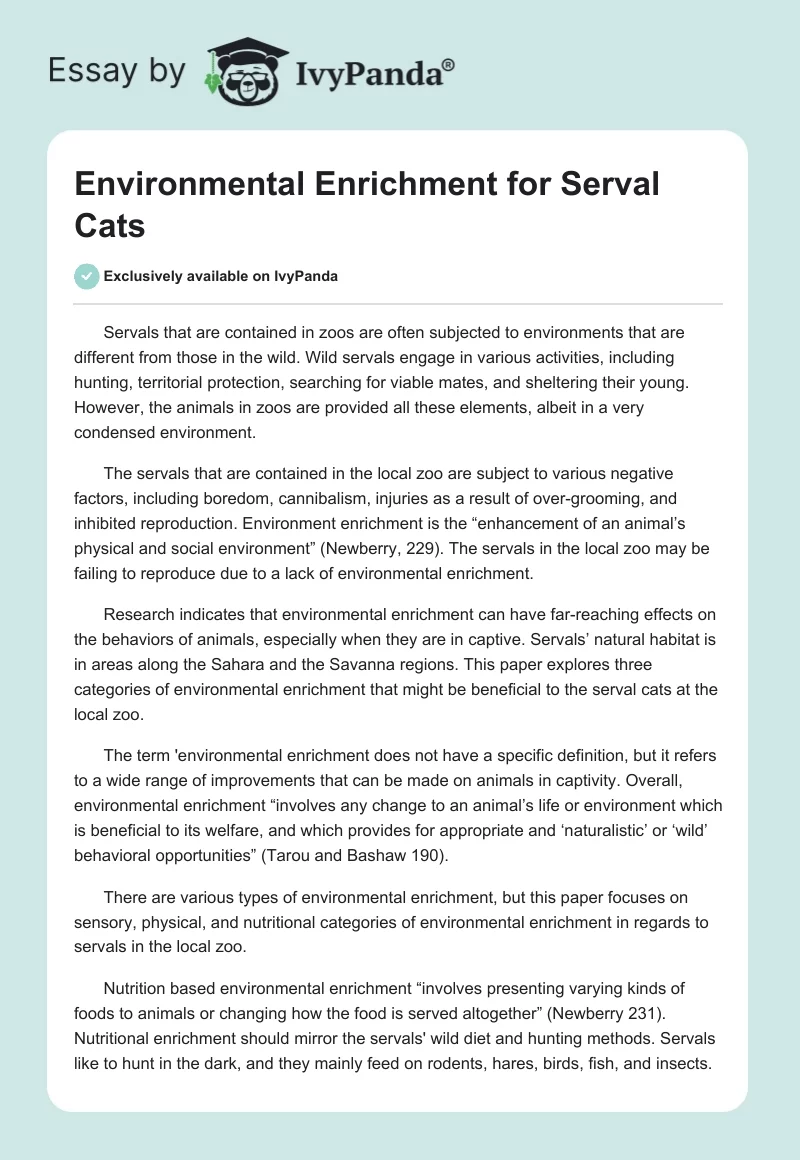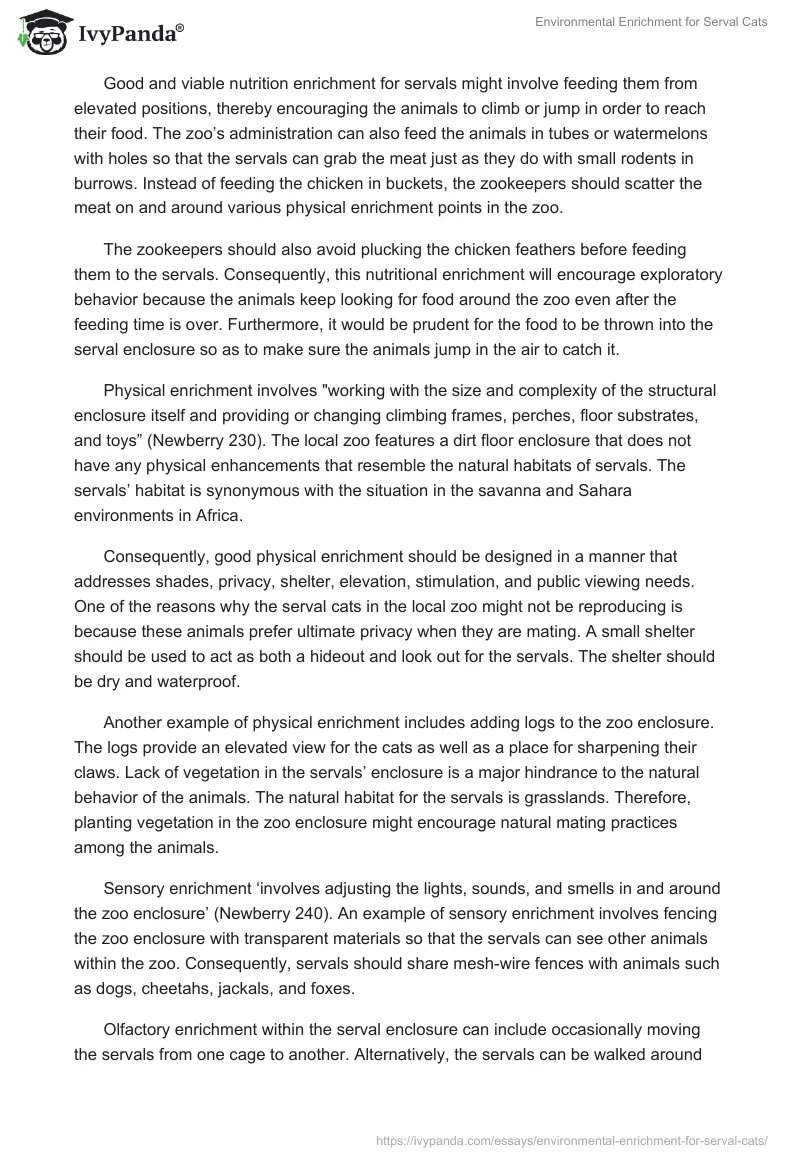Servals that are contained in zoos are often subjected to environments that are different from those in the wild. Wild servals engage in various activities, including hunting, territorial protection, searching for viable mates, and sheltering their young. However, the animals in zoos are provided all these elements, albeit in a very condensed environment.
The servals that are contained in the local zoo are subject to various negative factors, including boredom, cannibalism, injuries as a result of over-grooming, and inhibited reproduction. Environment enrichment is the “enhancement of an animal’s physical and social environment” (Newberry, 229). The servals in the local zoo may be failing to reproduce due to a lack of environmental enrichment.
Research indicates that environmental enrichment can have far-reaching effects on the behaviors of animals, especially when they are in captive. Servals’ natural habitat is in areas along the Sahara and the Savanna regions. This paper explores three categories of environmental enrichment that might be beneficial to the serval cats at the local zoo.
The term ‘environmental enrichment does not have a specific definition, but it refers to a wide range of improvements that can be made on animals in captivity. Overall, environmental enrichment “involves any change to an animal’s life or environment which is beneficial to its welfare, and which provides for appropriate and ‘naturalistic’ or ‘wild’ behavioral opportunities” (Tarou and Bashaw 190).
There are various types of environmental enrichment, but this paper focuses on sensory, physical, and nutritional categories of environmental enrichment in regards to servals in the local zoo.
Nutrition based environmental enrichment “involves presenting varying kinds of foods to animals or changing how the food is served altogether” (Newberry 231). Nutritional enrichment should mirror the servals’ wild diet and hunting methods. Servals like to hunt in the dark, and they mainly feed on rodents, hares, birds, fish, and insects.
Good and viable nutrition enrichment for servals might involve feeding them from elevated positions, thereby encouraging the animals to climb or jump in order to reach their food. The zoo’s administration can also feed the animals in tubes or watermelons with holes so that the servals can grab the meat just as they do with small rodents in burrows. Instead of feeding the chicken in buckets, the zookeepers should scatter the meat on and around various physical enrichment points in the zoo.
The zookeepers should also avoid plucking the chicken feathers before feeding them to the servals. Consequently, this nutritional enrichment will encourage exploratory behavior because the animals keep looking for food around the zoo even after the feeding time is over. Furthermore, it would be prudent for the food to be thrown into the serval enclosure so as to make sure the animals jump in the air to catch it.
Physical enrichment involves “working with the size and complexity of the structural enclosure itself and providing or changing climbing frames, perches, floor substrates, and toys” (Newberry 230). The local zoo features a dirt floor enclosure that does not have any physical enhancements that resemble the natural habitats of servals. The servals’ habitat is synonymous with the situation in the savanna and Sahara environments in Africa.
Consequently, good physical enrichment should be designed in a manner that addresses shades, privacy, shelter, elevation, stimulation, and public viewing needs. One of the reasons why the serval cats in the local zoo might not be reproducing is because these animals prefer ultimate privacy when they are mating. A small shelter should be used to act as both a hideout and look out for the servals. The shelter should be dry and waterproof.
Another example of physical enrichment includes adding logs to the zoo enclosure. The logs provide an elevated view for the cats as well as a place for sharpening their claws. Lack of vegetation in the servals’ enclosure is a major hindrance to the natural behavior of the animals. The natural habitat for the servals is grasslands. Therefore, planting vegetation in the zoo enclosure might encourage natural mating practices among the animals.
Sensory enrichment ‘involves adjusting the lights, sounds, and smells in and around the zoo enclosure’ (Newberry 240). An example of sensory enrichment involves fencing the zoo enclosure with transparent materials so that the servals can see other animals within the zoo. Consequently, servals should share mesh-wire fences with animals such as dogs, cheetahs, jackals, and foxes.
Olfactory enrichment within the serval enclosure can include occasionally moving the servals from one cage to another. Alternatively, the servals can be walked around the zoo in a collar. The zoo should invest in a few play-toys for the animals. These toys should be placed in the physically enriched zoo enclosure, and they should include ropes and rubber items. Balls and other stuffed animals can also provide sensory enrichment for the servals.
The servals at the local zoos can benefit from several forms of environmental enrichment. The failure by the servals to reproduce indicates that the animals are missing crucial, environmentally stimulating factors. Planting vegetation in the zoo enclosure would enrich the cats’ physical environment and make it natural. The servals can also benefit from a change in their feeding patterns.
Works Cited
Newberry, Ruth. “Environmental enrichment: increasing the biological relevance of captive environments.” Applied Animal Behaviour Science 44.2 (2005): 229-243. Print.
Tarou, Rybiski and Meredith Bashaw. “Maximizing the effectiveness of environmental enrichment: suggestions from the experimental analysis of behavior.” Applied Animal Behaviour Science 102.3 (2007): 189-204. Print


